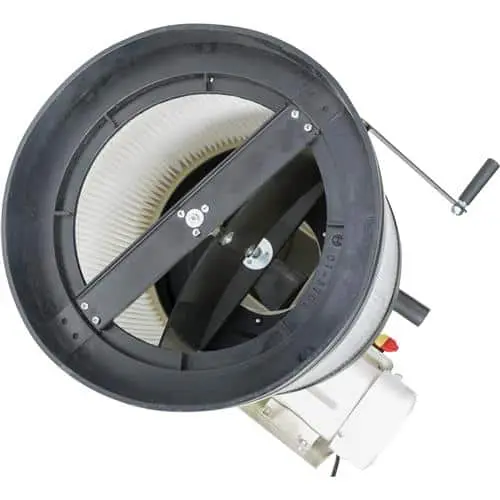If you are on the market for a wall-mounted dust collector, you may consider the Shopfox W1844. It has a large surface area and pleated filters with internal paddle brushes. There is a canister filter for added convenience.
If you didn’t know that these two determine the dust collector’s efficiency. Well, now you do.
This wall-mounted Dust Collector is designed to capture dust at the source, eliminating the reduced efficiency of a duct system when you find that its efficiency is diminished due to dust cake.
Just a couple of turns of the handle rotates the paddle brushes against the inside of the filter to drop the fine dust cake into the plastic collection bag. It’s as easy as that. Its 537 CFM capacity will handle just about any dust thrown in its face. It’s a great dust collector—one of the best. So don’t waste any time, hurry and get yours as soon as possible.
Pros
- It is a versatile machine that allows for effective collection of dust
- The ten in. cast-aluminum impeller construction ensures durability
- Offers maximum air suction capacity
- Keeps a room’s air circulation clean
- Dust collection allows for easy disposal
Cons
- The purchase price may seem a bit high
- Maintenance and repairs may set off high prices as well
Specifications
- Motor: 1 HP, 120V/240V (pre-wired 120V), 7A/3.5A
- Air suction capacity: 537 CFM
- Static pressure: 7.2″
- Filter rating 1 micron
- Bag capacity: 1.5 cubic feet
- Intake hole size: 4″
- Impeller: 10″ balanced cast aluminum radial fin
- Canister filter size (diameter x length): 15″ x 16-3/16″
- Height with bag inflated: 46″
- Sound level: 77-79 dB
- Approximate shipping weight: 62 lbs.

General Guide
How Does a Dust Collector Work?
Dust collectors are designed with a powerful 1 HP or 1.5 HP motor and a strong impeller fan that creates speeds of 3450 RPM for smaller dust collectors or 6,000 RPM for larger machines. A dust collector is very easy to use. Just attach it to your wood cutting, beveling, or wood smoothing tool with a flexible hose, and the advanced filtration system will suck the dust out into an attached collection bag. Once the bag is complete, you can safely dispose of the dust in the trash.
How do you choose a Dust Collector?
Consider these important features to find the right dust collector for your workshop.
Filtration System
Dust collectors are designed with either a single-stage or two-stage filtration system.
Single-Stage Dust Collector
If you have a small workshop or a hobby woodworker, a single-stage dust collector is perfect. A single-stage dust collector’s filtration system captures dust particles with 2 or 2.5 microns, which is sufficient for most small-medium woodworking tasks.
Two-Stage Dust Collector
A two-stage or cyclonic dust collector is a must-have machine for any DIY woodworking enthusiast or a professional carpenter. Extremely efficient, a two-stage dust collector has improved suction power that can suck up the smallest of dust particles down to 1 micron and larger wood chips. This type of dust collector is ideal for medium-to-large woodworking tasks, but it might be too bulky for a small workspace.
Dust Separator
If you already have a wet/dry shop vacuum, you can transform your vacuum into a two-stage dust collector by attaching a dust separator.
Wall Mounted and Mobile Dust Collectors
If your workshop has limited space consider a wall-mounted dust collector. If you are looking for a unit that you can transport easily around your work area, consider a dust collector with a rolling base or a mobile dust extractor.
Cubic feet per minute (CFM)
To find the right dust collector for your work needs, think about the CFM rating of the power tools that you use daily. The airflow speed of a dust collector is measured in cubic feet per minute, which is usually between 537 to 800 CFM. For instance, a bandsaw can create between 300 to 400 CFM and a 500 to 800 CFM planer.
Dust Collection Bag
A dust collector may have a plastic collection bag or a collection drum. Plastic collection bags are straightforward to empty and may also have a viewing window that helps you to monitor the amount of dust inside the bag. Even though a plastic bag is lighter than a collection drum, the bag can break if you overfill it.
Hose/Inlet Port Sizes
You also have to consider the size of the hose or the inlet port that connects the dust collector to your woodworking machine. A dust collector may have a two or 4-inch inlet or hose, so make sure that you check the size of the port on your miter or band saw first. You also need to be aware that the hose may or may not come with the dust collector.
Noise Production
The noise production of a dust collector will depend on its suction power and filtration system. Fortunately, most dust collectors produce an acceptable noise level in the 70 to the 90-decibel range. A more powerful dust collector can still be too noisy in a small workspace, so invest in ear protection.
Our Verdict
Woodworking tools like a band saw, a miter saw or a belt sander, generate a lot of fine dust that is tough to clean up and hazardous to your health. Sometimes called a dust extractor, a dust collector is indispensable to woodworking enthusiasts. Whether you work at home or in a professional carpentry shop, a dust collector will help you work smarter by creating a dust-free workspace full of fresh, clean air.
Resources
- Grain and Sheen: Teak Oil versus Danish Oil Uncovered - January 10, 2024
- The Cherry on Top: Crafting the Perfect Cutting Board - January 9, 2024
- Polyurethane Water-Based vs Oil-Based: Choosing the Right Finish - January 8, 2024
